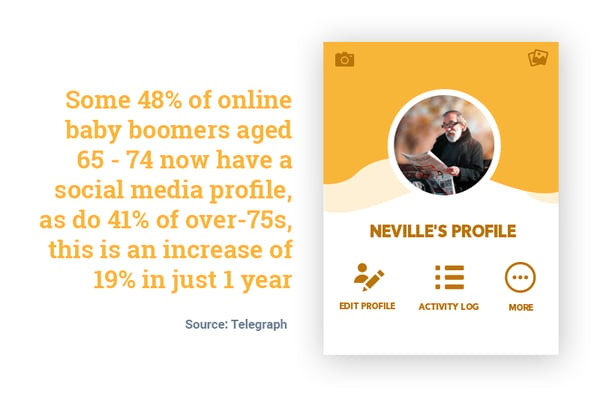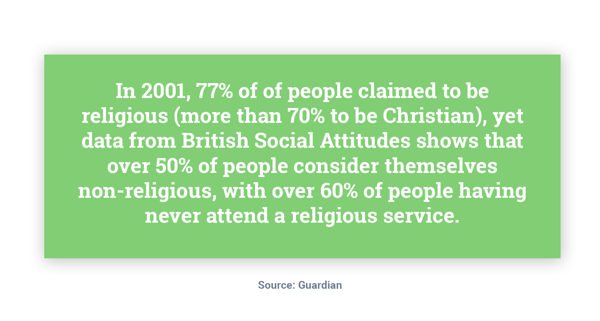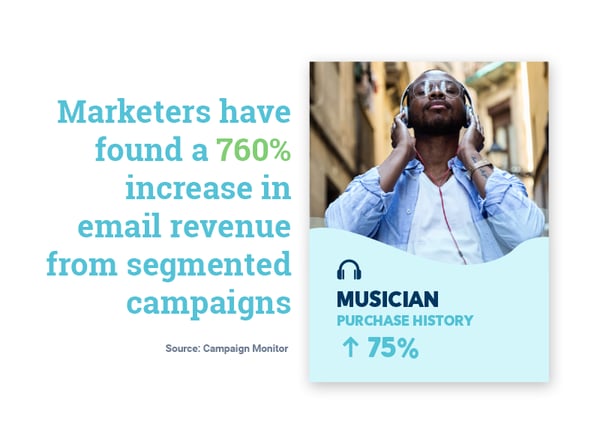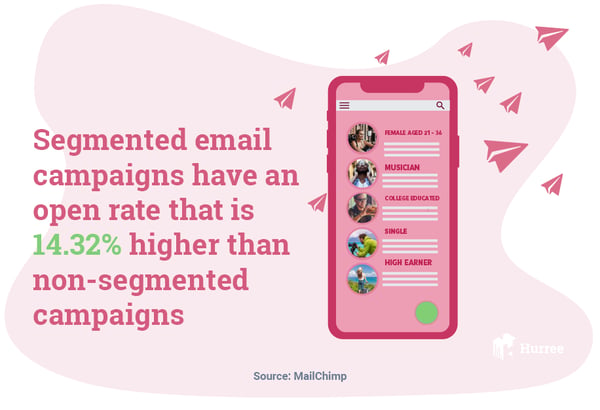The Pros and Cons of Demographic Segmentation
One of the most important things for brands is understanding and catering to the needs and wants of current and prospective target markets. And one simple way to achieve this is through market segmentation.
In its essence, market segmentation is essentially grouping users based on common or shared attributes. The benefits of market segmentation can't be overlooked. Along with organising your customer relationships and optimising user experiences (UX), the advantages for the brand, too, are clear.
Using segmentation techniques in your email marketing strategy increases open rates by 15%, open rate 100% higher and can drive 3x as much revenue as a generic broadcast email. With figures like this, it's obvious that segmentation is a highly effective strategy in a marketer's arsenal.
Segmentation based on demographic information is one of the most common ways for marketers to group users. And that’s what we’re going to explore further in this blog.
But first, let’s take it back a step...
What is demographic segmentation?
Demographic segmentation is a type of market segmentation that takes into account basic demographics to group and segment users. These demographics primarily focus on subjects such as age, sex, education level, marital status, social status, income, occupation, and nationality.
Brands and marketers use demographic segmentation to focus and streamline their resources effectively, whilst also getting to know their current and prospective consumers better. Demographic segmentation tends to be one of the first stops when brands begin to segment their users. And this is because demographics offer some of the most common and easy to interpret statistics that can be used to group entire populations.
It all sounds perfect, right? It’s true that there are loads of advantages to organising your consumers based on demographic information, however, there are also disadvantages to this kind of market segmentation. And we’re going to take a look at both.
First of all, let’s start off with the advantages. The ‘Pros’, of demographic segmentation:
-
Data is easy to obtain
One way to access demographic information is via government-maintained census data, which is readily available to the public. It’s generally updated every 10 years and, believe me, there’s a lot of it. The data can be accessed, for free, online and in some areas you can get hold of demographic data through National Archives, like in Washington, DC, Kew, England, and many more places.
Most often the most popular and most reliable way to obtain demographic data is through online or offline surveys and interviews. This could be via free tools such as SurveyMonkey, Typeform or Google Analytics. And, thanks to the increasing number and variety of internet and social media users, surveys can successfully be distributed via email or via your social media channels.

-
Straightforward targeting and analysis
If you’re using an online tool such as Google Analytics, not only will Google collect the data, but they will also analyse it for you, too - that’s a bonus! Other online tools like SurveyMonkey also offer their own analysis, which streamlines the gathering-and-analysing process without you having to lift a finger. If you’re looking to do your own independent analysis, tools such as SPSS can also analyse your data sets and interview results, which are then easily implemented in your marketing strategy.
-
Cost-effective
Not only is census data is readily available, both online and offline, but it is also free to access (which is always good news!). In addition to census data, there is the option of online surveys, which have been mentioned previously. They’re super convenient and the number of free online survey tools for data collection, as well as data analysis, is increasing by the day.
-
Easy to measure
Demographic data tends to be easier to assess and measure due to the availability of the data itself, the steady flow of updates, and the uncomplicated nature of the information itself. It’s certainly more straightforward than, say, psychographic data, which can be subjective, ambiguous and harder to obtain. Demographic data relies on simple facts about individuals, and it’s this simplicity that makes it so measurable and actionable.
- Customer retention and loyalty
It makes sense that customers want to feel like the messages they are receiving from a brand are specific to them and not just a generic spiel to everyone. Segmentation creates a more personalised approach, making a customer feel like their needs and wants are being understood and catered for. Naturally, this makes the customers feel valued and in turn, helps to create more loyal customers. With more loyal customers, brings more revenue and customer retention. 56% of customers spend on brands that they are loyal to, even if there are cheaper options available. So it pays off to segment your customers.

Source: Zendesk
-
Ideal for monitoring trends and social shifts
Demographic data is a great way to monitor societal trends and shifts over time, both online and offline. This is because the data itself is basic, so the categories and criteria rarely change. Identifying trends can help brands to track, monitor and analyse the customer journey, and can also help make market predictions for the future, for the benefit of both the brand and the consumer.
Segmentation helps to focus marketing efforts, making sure products, campaigns, services, and communications are streamlined and delivered to the most appropriate audience for that brand.
Whilst there are a lot of advantages to demographic segmentation, there are also a number of disadvantages.
So here we go, our disadvantages, or the ‘Cons’, of demographic segmentation.
-
Based on assumptions
Demographic segmentation is mostly criticised for its one-dimensional approach. By this, we mean that grouping people based on simple demographic information can lead to brands making blanket statements about consumers. So while segmentation does drill down into attributes of your customers, it sometimes isn't enough to truly create a personalised experience for them and can create the risk of generalisation and stereotyping.
Take Millennials, for example. Often people stereotype someone in the millennial age bracket as a ‘snowflake’, i.e. someone who is entitled or sensitive, and this assumption has the potential to cause offence, which subsequently taints and hinders marketing efforts.
The same can be said for the common misconception that people in the 65+ age bracket are technologically challenged. Using this assumption, a mobile phone company for example, might target those customers with basic models of mobile phones, but in actual fact the internet usage in this age group is increasing. It rose from 52% in 2011 to 83% in 2019, and is likely to continue increasing.
-
Demographic data is too vague
Whilst demographic data can tell you a person’s age or how much they earn in a year, this information doesn’t give you insights into the individual’s character or their consumer wants and values. Take the likes of Spotify or Netflix: music and entertainment industries aren’t likely to benefit too much from demographic segmentation. This is because a user’s income or education level doesn’t give us any clues as to whether they enjoy comedy films or horror.
Similarly, music is such a subjective topic so it makes sense for Spotify to track behaviour and listening preferences over anything else. In this sense, demographic data is too vague to create any tailored marketing content or communications that are also accurately actionable and effective.
-
Alienates people
Demographic data has the potential to alienate consumers. The very nature of this type of data collection and analysis means that people are sometimes categorised based on facts that are shallow or redundant. By this, I mean that demographic data assumes that individuals in the same demographic categories also have the same needs, interests, and attributes.
On the other side of the coin, demographic segmentation runs the risk of alienating people that don’t fit snugly into a general, demographic mould. Not only are these assumptions often inaccurate, they can also be offensive.
-
Misinterpreting data
Essentially, demographic data can be seen as quite outdated. Over the years our lifestyles have changed dramatically. And what was once the norm is now not-so-normal. From things such as the increase in mobile phone usage to gender fluidity, demographic data is simply not enough anymore.
Google gives the example of marketing to ‘new moms’: Years ago, based on standard demographics, brands promoting baby products would typically have targeted women aged 20-35 years, with an average income. However, things have changed. The number of men now taking joint responsibility for child care, women having children later on in life, or individuals deciding to live child-free is ever-increasing.
The changing times also brings with it changes to how people identify in terms of gender. Around 2-3% of the population in European cities identify as transgender, gender fluid or non-binary, so it's not as easy as segmenting your audience into male and female, and targeting them what you think is relevant messaging. Marketers now need to be more sensitive and aware of how society is changing so a one-size-fits-all demographic segmentation approach may no longer be enough.

Source: McKinsey
-
Change
Demographic data has the ability to change at the drop of a hat; age changes every year (of course), people's incomes change, their marital status, education level, occupation, the list goes on. So, in this sense, census data is not as reliable as it once was. Furthermore, it’s hard to guarantee that the information given by individuals will always be true.
If you’re looking at social data, it wouldn't be uncommon for someone to lie about their occupation on Facebook, for example. Or if you send out anonymous surveys you just have to trust, blindly, that the participant is being truthful. This differs from the likes of behavioural segmentation where marketers can track in-app activity or browsing habits.

So there you have it. Our pros and cons of demographic segmentation, and its impact on your marketing strategies. Just to clarify, we’re not saying to ignore demographics completely, quite the opposite - they still have the ability to add value to your marketing.
However, the most important thing is to determine whether or not demographic segmentation is right for you, i.e. will it lead to brand success and improved experiences for your consumers? It would be fair to say that demographic data is more valuable when combined with other forms of market segmentation and analysis. For example, demographic segmentation absolutely has the potential to add value to broader behavioural or psychographic segmentation efforts.
Anything that helps you better understand your customers has to be a good thing, right? But whichever type, or types, of market segmentation you decide to incorporate into your marketing strategy, just make sure that your data gathering and analysis efforts are appropriate, valuable, actionable, non-intrusive and GDPR compliant - that way, everybody wins!
Book a free demo today to see how Hurree can help you transform your company reporting and improve your sales & marketing output 💌 Don't hesitate to get in touch via contact@hurree.co if you have any inquiries - we’re happy to chat!
Share this
You May Also Like
These Related Stories

Behavioural Segmentation: 3 Case Studies

7 Essential Elements of Firmographic Segmentation





